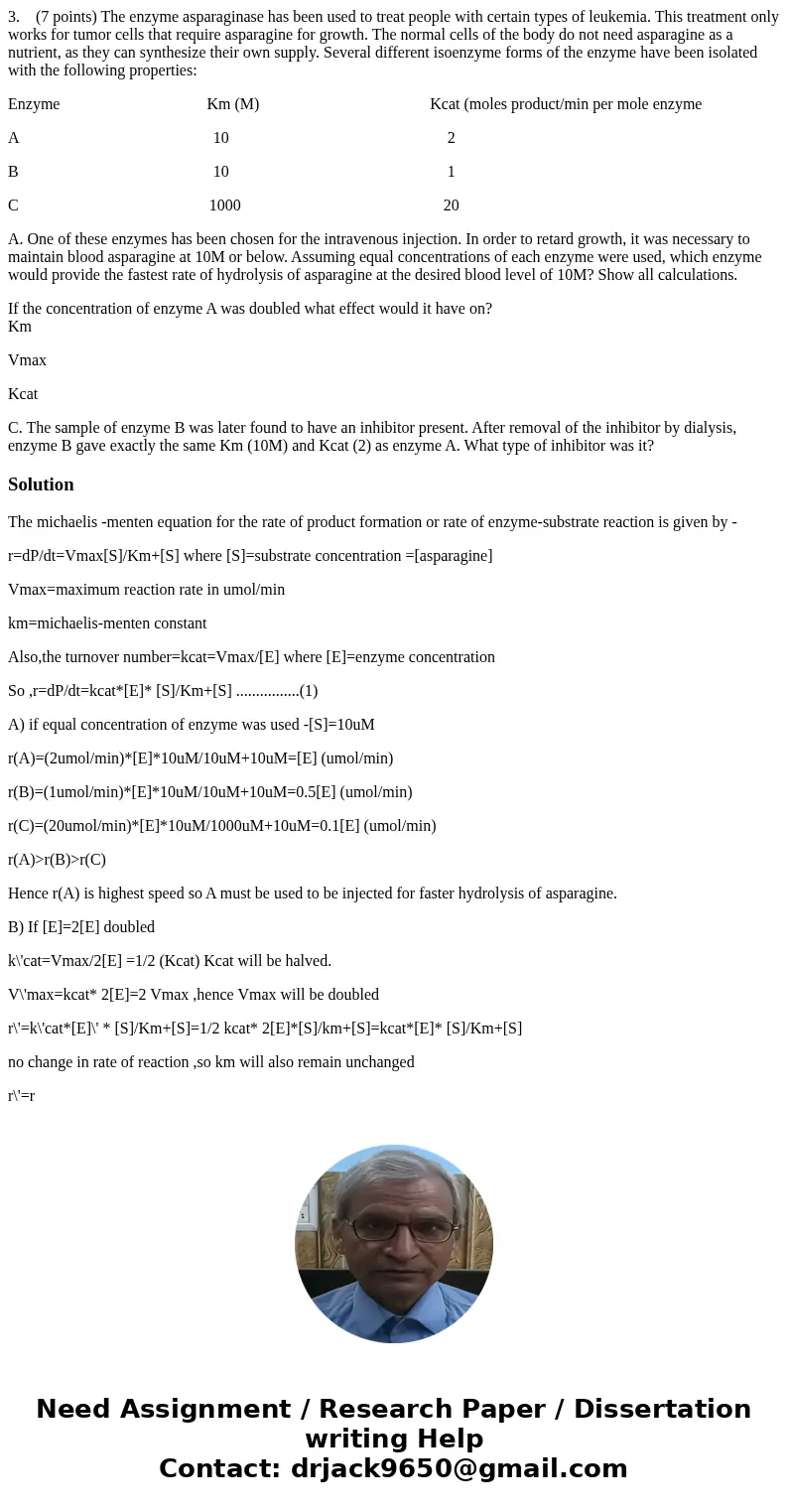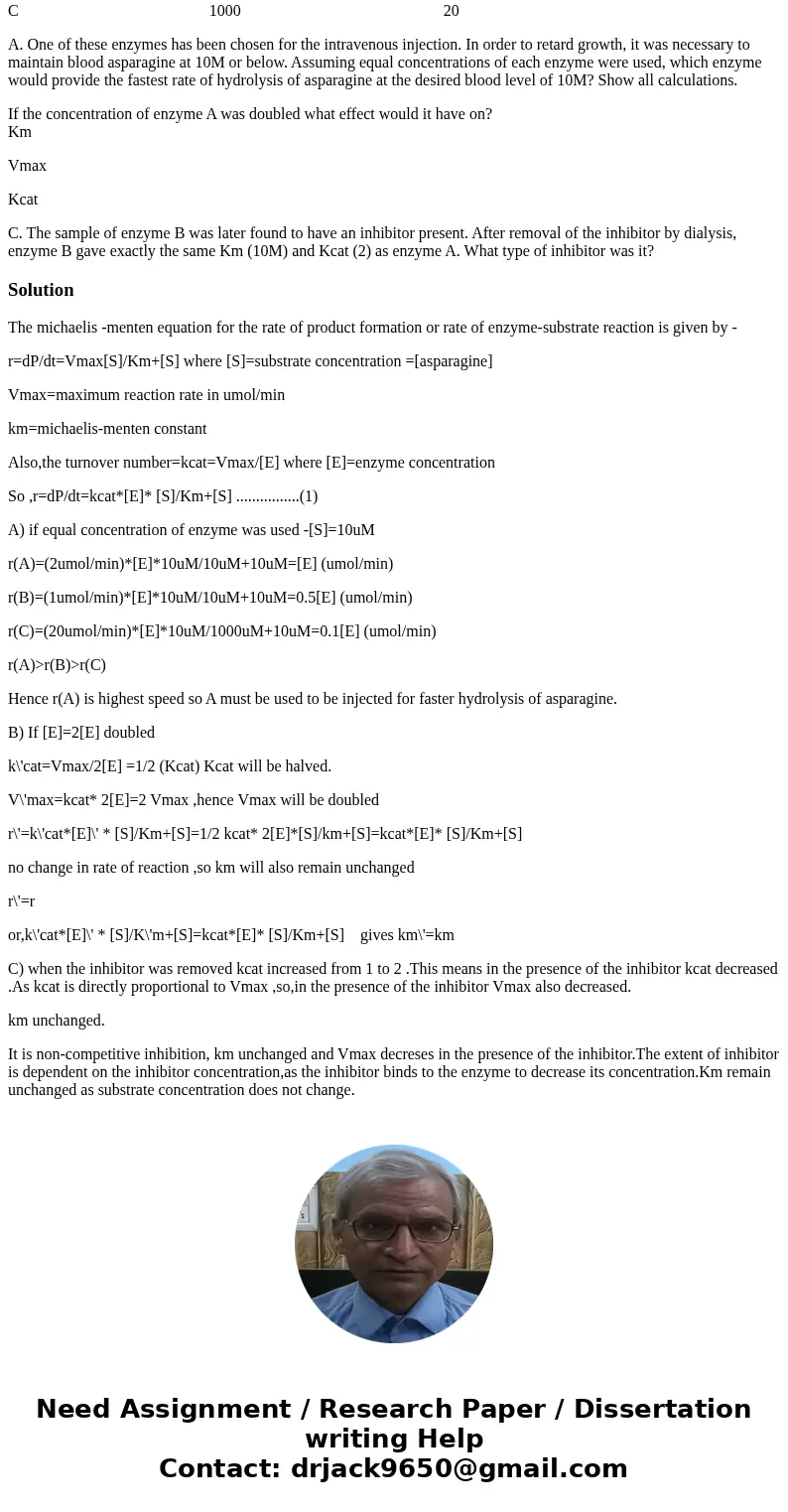3 7 points The enzyme asparaginase has been used to treat pe
3. (7 points) The enzyme asparaginase has been used to treat people with certain types of leukemia. This treatment only works for tumor cells that require asparagine for growth. The normal cells of the body do not need asparagine as a nutrient, as they can synthesize their own supply. Several different isoenzyme forms of the enzyme have been isolated with the following properties:
Enzyme Km (M) Kcat (moles product/min per mole enzyme
A 10 2
B 10 1
C 1000 20
A. One of these enzymes has been chosen for the intravenous injection. In order to retard growth, it was necessary to maintain blood asparagine at 10M or below. Assuming equal concentrations of each enzyme were used, which enzyme would provide the fastest rate of hydrolysis of asparagine at the desired blood level of 10M? Show all calculations.
If the concentration of enzyme A was doubled what effect would it have on?
Km
Vmax
Kcat
C. The sample of enzyme B was later found to have an inhibitor present. After removal of the inhibitor by dialysis, enzyme B gave exactly the same Km (10M) and Kcat (2) as enzyme A. What type of inhibitor was it?
Solution
The michaelis -menten equation for the rate of product formation or rate of enzyme-substrate reaction is given by -
r=dP/dt=Vmax[S]/Km+[S] where [S]=substrate concentration =[asparagine]
Vmax=maximum reaction rate in umol/min
km=michaelis-menten constant
Also,the turnover number=kcat=Vmax/[E] where [E]=enzyme concentration
So ,r=dP/dt=kcat*[E]* [S]/Km+[S] ................(1)
A) if equal concentration of enzyme was used -[S]=10uM
r(A)=(2umol/min)*[E]*10uM/10uM+10uM=[E] (umol/min)
r(B)=(1umol/min)*[E]*10uM/10uM+10uM=0.5[E] (umol/min)
r(C)=(20umol/min)*[E]*10uM/1000uM+10uM=0.1[E] (umol/min)
r(A)>r(B)>r(C)
Hence r(A) is highest speed so A must be used to be injected for faster hydrolysis of asparagine.
B) If [E]=2[E] doubled
k\'cat=Vmax/2[E] =1/2 (Kcat) Kcat will be halved.
V\'max=kcat* 2[E]=2 Vmax ,hence Vmax will be doubled
r\'=k\'cat*[E]\' * [S]/Km+[S]=1/2 kcat* 2[E]*[S]/km+[S]=kcat*[E]* [S]/Km+[S]
no change in rate of reaction ,so km will also remain unchanged
r\'=r
or,k\'cat*[E]\' * [S]/K\'m+[S]=kcat*[E]* [S]/Km+[S] gives km\'=km
C) when the inhibitor was removed kcat increased from 1 to 2 .This means in the presence of the inhibitor kcat decreased .As kcat is directly proportional to Vmax ,so,in the presence of the inhibitor Vmax also decreased.
km unchanged.
It is non-competitive inhibition, km unchanged and Vmax decreses in the presence of the inhibitor.The extent of inhibitor is dependent on the inhibitor concentration,as the inhibitor binds to the enzyme to decrease its concentration.Km remain unchanged as substrate concentration does not change.


 Homework Sourse
Homework Sourse